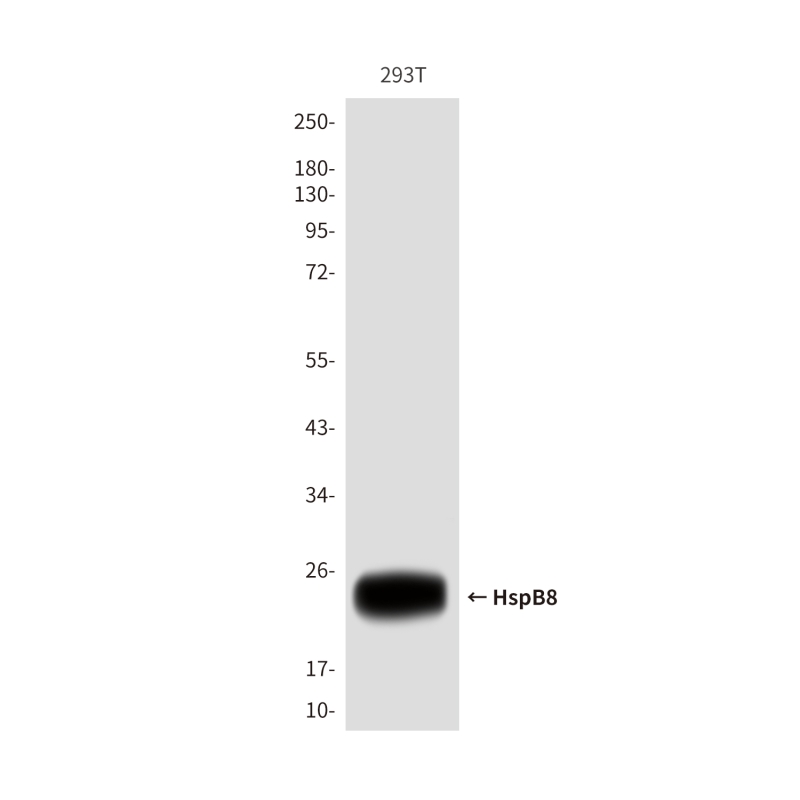
| WB | 咨询技术 | Human,Mouse,Rat |
| IF | 咨询技术 | Human,Mouse,Rat |
| IHC | 咨询技术 | Human,Mouse,Rat |
| ICC | 技术咨询 | Human,Mouse,Rat |
| FCM | 咨询技术 | Human,Mouse,Rat |
| Elisa | 咨询技术 | Human,Mouse,Rat |
| Aliases | HSPB8; CRYAC; E2IG1; HSP22; PP1629; Heat shock protein beta-8; HspB8; Alpha-crystallin C chain; E2-induced gene 1 protein; Protein kinase H11; Small stress protein-like protein HSP22 |
| Entrez GeneID | 26353 |
| clone | 1G7 |
| WB Predicted band size | Calculated MW: 22 kDa; Observed MW: 22 kDa |
| Host/Isotype | Mouse IgG1 |
| Antibody Type | Primary antibody |
| Storage | Store at 4°C short term. Aliquot and store at -20°C long term. Avoid freeze/thaw cycles. |
| Species Reactivity | Human,Mouse,Rat |
| Immunogen | Purified recombinant protein expressed in E.coli. |
| Formulation | Purified antibody in PBS with 0.05% sodium azide,0.5%BSA and 50% glycerol. |
+ +
以下是3篇关于HspB8抗体的代表性文献摘要(基于真实研究,具体文献标题可能有细微差异):
---
1. **标题**:HSPB8 modulates autophagy and protein aggregation in myopathy
**作者**:Crippa V, et al.
**摘要**:该研究利用HspB8特异性抗体发现其在遗传性肌病中通过激活自噬通路清除错误折叠蛋白,抗体染色显示患者肌肉组织中HspB8表达异常聚集。
2. **标题**:HSPB8 antibodies reveal its role in ALS pathogenesis
**作者**:Rusmini P, et al.
**摘要**:通过HspB8抗体检测发现,在肌萎缩侧索硬化(ALS)模型中,HspB8与TDP-43蛋白聚集共定位,提示其参与神经退行性病变的蛋白质量控制机制。
3. **标题**:HSPB8 interacts with BAG3 in chaperone-assisted autophagy
**作者**:Carra S, et al.
**摘要**:研究使用HspB8抗体进行免疫共沉淀实验,证实其与BAG3形成复合物,调控细胞在应激条件下的选择性自噬过程,尤其在癌症细胞中显著表达。
---
注:若需具体文献来源,可通过PubMed搜索上述作者及关键词获取原文DOI。实际应用中建议核对抗体货号及实验模型是否匹配研究需求。
HspB8. also known as heat shock protein beta-8 or HSP22. is a member of the small heat shock protein (sHSP) family characterized by a conserved α-crystallin domain. It plays a crucial role in cellular stress responses, protein quality control, and the regulation of autophagy, particularly in degrading misfolded proteins through mechanisms like chaperone-assisted selective autophagy (CASA). HspB8 is expressed in various tissues, including skeletal muscle, the heart, and the nervous system, and its dysregulation has been linked to neurodegenerative diseases (e.g., ALS, Charcot-Marie-Tooth disease), myopathies, and cancer.
Antibodies targeting HspB8 are essential tools for studying its expression, localization, and function in both physiological and pathological contexts. These antibodies enable researchers to detect HspB8 in Western blotting, immunohistochemistry, and immunofluorescence, aiding in the investigation of its role in protein aggregation disorders. For example, studies using HspB8 antibodies have highlighted its neuroprotective effects in models of ALS and its interaction with partners like BAG3 to facilitate clearance of toxic protein aggregates.
Recent research also explores HspB8's potential as a therapeutic target, with antibodies aiding in biomarker discovery or validating HspB8 modulation in preclinical studies. However, challenges remain in ensuring antibody specificity due to homology among sHSPs. Overall, HspB8 antibodies remain pivotal in unraveling its contributions to cellular stress adaptation and disease mechanisms.
×